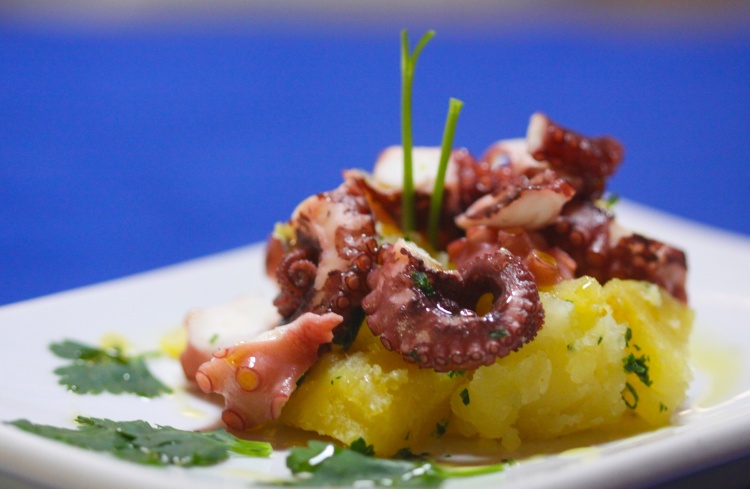The octopus is a classic of Italian cuisine and a beloved by all connoisseurs of seafood and fish. OK, the sight of it is a bit threatening, but when approached with the right mind-frame, it is not difficult at all to handle and get out quite a deliciuos meal. Most of all, it always comes already cleaned, often also defrosted, so you need to cook it right away.
To be properly cooked you need precise steps and special attention. Here are some tricks to boil octopus to perfection, creating a tasty dish, suitable for all seasons. Let’s start with some precautions to recognize freshness and varieties.

Knowing the Octopus
Learning to recognize the best varieties is a must. There are a few varieties in the Mediterranean:
Octopus of rock (Octopus vulgaris, or Polipo di scoglio in Italian), more valuable and above all more suitable for boiling, is recognized by the double row of suckers on the tentacles and the larger size (I’m nor sure those round things on the tentacles are called suckers though 🙂
Moscardino also called sand octopus (Eledone moschata), smaller and more suited to recipes that include cooking in a pan or fried, it comes with a single row of suckers.
Polpessa (Octopus macropus) which is not the female of the Octopus vulgaris, but belongs to another specie, much less valuable, and has thinner and longer tentacles, two more than the others, moreover it has a reddish color with white dots.

At the time of purchase look for
Intense color: the true octopus has a strong color, not “faded” but tending to red
Strong consistency: the stiffness of the fibers is an indication of freshness, while an octopus with a flaccid flesh is definitely to be avoided, as an indication of an old fish
Curled tentacles: the curled tentacles are synonymous with old or thawed octopuses, while the fresh ones have them stretched out.
Boiling the Octopus
Tradition has it that the octopus is boiled in the classic earthenware pot, but if you lack one, you can safely use your regular pot filled with water up to ¾ and sparingly salt the water.
Gradual immersion of the tentacles; another precaution that will guarantee to obtain tender meat, is to take it by the head and dive the tentacles in the boiling water, then lift it and repeat the operation a couple of times before dipping it completely. This step serves to make the tentacles curl.
Simmer do not boil; boiling is harsh and there is a risk of breaking the skin. The cooking water should instead simmer—not boil—so the flame should always be kept to a minimum. Long cooking makes the octopus chewy and fibrous
Cooking times; to be tender the octopus must be cooked in a pot with plenty of water for 15 minutes. No more! As soon as this time has elapsed, just turn off the heat, leaving the octopus soaking with a lid, letting it cool in its own water.
That’s done how should it be consumed–cold or at room temperature?
In the south of Italy, it is the norm to consume the octopus lukewarm, not cold, with freshly ground black pepper or with extra virgin olive oil, and lemon.
It is also served with salads, accompanied with green olives and celery.

Popular Ways to Serve Octopus
Octopus alla Luciana – A Neapolitan delicatessen. It is practically stewed with tomato’s sauce.
Pulpo Gallego – a Spanish recipe that requires also sweet paprika
My favorite is with boiled potatoes
Once the octopus is ready, squeezed it in a small bowl–as small as you can–cover tightly with kitchen plastic film and put some weight on top to keep it tight & squeezed. Refrigerate, even overnight. This will make it easy to slice it as thick or thin as you like.

That same octopus can be cut in bigger chunks and served with steamed potatoes, with a citronette to dress, with a sprinkle of minced parsley.
And Better yet with Fennel and Oranges

In winter I always make Fennel and Oranges salad because is fresh and provides a little diversity to the traditional winter dishes. Adding an octopus adds a little excitement to the dish.
Fennel and oranges is a simple dish, it only requires a little skill to shave the fennel and cut the oranges in wedges.
Ingredients
2 medium fennel bulbs
1 or 2 oranges
½ lemon, juice only
extra virgin olive oil
salt and freshly ground black pepper
Cut off the tops of the fennel bulbs, Shave the fennel with the using a speed peeler, then place in a bowl of ice water.
Peel the oranges, removing the white membrane as much as possible. Cut between membranes to release segments.
In a serving dish add the oranges segments to the fennel

Make the salad dressing by mixing the orange juice from half the orange, the lemon juice, an equal amount of olive oil and salt and freshly ground black pepper.
Drizzle over the fennel and oranges, sprinkle with some minced parsley, use some for decoration, and serve.
Or not yet! Wait, let’s add the Octopus

As above, squeezed it in a small bowl, cover tightly with kitchen plastic film and put some weight on top to keep it tight. Once it has cooled down, remove it from the bowl and sliced it very thinly. For this dish you really need a sharp chef knife.
Add the slices of octopus to the salad, add some of the same dressing and serve.
Wherever you consume it, octopus is one of those products so perfect that it can be tasted naturally and without even a spice, but if you are a lover of Mediterranean flavors you cannot pass.
